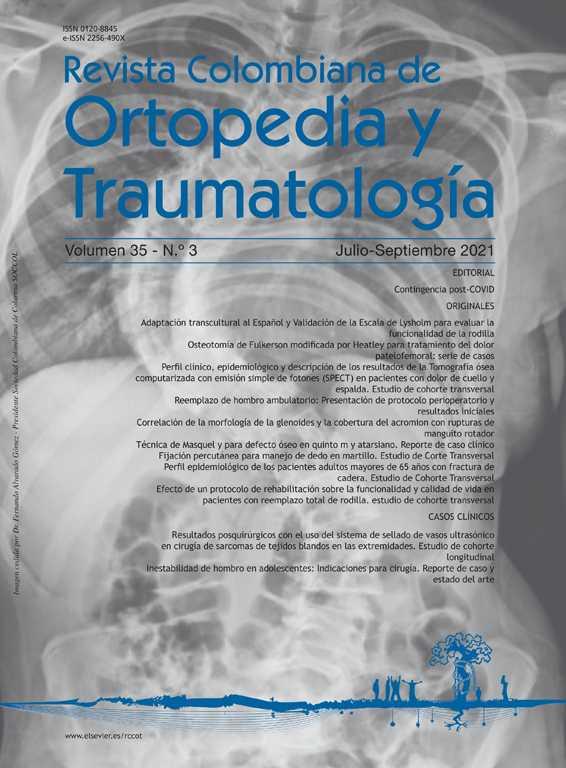Epidemiological profile of adult patients older than 65 years with hip fracture. Cross-sectional study
DOI:
https://doi.org/10.1016/j.rccot.2021.07.001Keywords:
Hip fractures, Fracture fixation, Arthroplasty, Mortality, Postoperative complications, Patient readmissionAbstract
Background: Hip fractures are a pathology with an increasing incidence, represent a challenge for public health due to the high socioeconomic cost and high morbidity and mortality. It is important to document the complications in our population, as well as the reasons for readmission to be able to propose strategies that contribute to reducing them.
Method: A descriptive, cross-sectional, retrospective study was conducted in the period between January 2015 and December 2017. All patients with hip fractures older than 65 years were included. Those with pathological fractures and patients with a history of fracture in that hip were excluded. The variables of age, sex, pathological antecedents, use of anticoagulants, type of fracture, intra-surgical and postoperative complications and total time from fracture to surgical management were collected.
Results: 155 hip fractures were properly documented, mean age 81.6 years, 74.8% were women. The most frequent fracture was the intertrochanteric (46.5%). 93.6% of the cases received surgical management, being hip arthroplasty the most performed procedure. Surgical management was performed in 85.16% of patients before 48 h and 40% before 24 h from the time of fracture. The readmission rate was 20% and the main cause was new fractures 5.8%
Discussion: We consider the approach of patients from a multidisciplinary standpoint that treat the comorbidities, bone fragility, muscle weakness and alterations in the mental sphere, because that may possibly affect the outcome of patients in a positive way.
Evidence level: III
Downloads
References
González ID, Becerra MC, González J, Campos AT, Barbosa-Santibáñez J, Alvarado R. Fracturas de cadera: satisfacción posquirúrgica al año en adultos mayores atendidos en Méderi-Hospital Universitario Mayor, Bogotá, D.C. Rev Cienc Salud. 2016;14:409-22, http://dx.doi.org/10.12804/revsalud14.03.2016.08.
Cornwall R, Gilbert MS, Koval KJ, et al. Functional outcomes and mortality vary among different types of hip fractures: a function of patient characteristics. Clinical Orthopaedics & Related Research. 2004 Aug;425:64-71.
Butler M, Forte M, Kane RL, et al. Treatment of Common Hip Fractures. Evidence Report/Technology Assessment, No. 184. AHRQ Publication No. 09-E013. Rockville. MD: Agency for Healthcare Research and Quality;. 2009.
zuckerman JD. Hip fracture. N Engl J Med. 1996;334:1519-25. 5. Dy CJ, McCollister KE, Lubarsky DA, Lane JM. An economic evaluation of a systems-based strategy to expedite surgical treatment of hip fractures [published correction appears in J Bone Joint Surg Am. 2011;93(14):1334]. J Bone Joint Surg Am. 2011;93:1326-34.
International Osteoporosis Foundation. Facts and statistics. International Osteoporosis Foundation.
González LA, Vásquez GM, Molina JF. Epidemiología de la osteoporosis. Rev. Colomb. Reumatol. 2009;16:61-75.
Keene GS, Parker MJ, Pryor GA. Mortality and morbidity after hip fractures. Br Med J. 1993;307:1248-60.
Folbert EC, Hegeman JH, Gierveld R, et al. Complications during hospitalization and risk factors in elderly patients with hip fracture following integrated orthogeriatric treatment. Arch Orthop Trauma Surg. 2017;137:507.
Mosquera CW, Rueda G, Cabezas CA, Tovar JL, Rodríguez HA. Complicaciones postoperatorias tempranas en reemplazo primario de cadera por artrosis entre 2012-2016. Repertorio de Medicina y Cirugía. 2017;26:152-7.
Gromov K, Bersang A, Nielsen CS, Kallemose T, Husted H, Troelsen A. Risk factors for post-operative periprosthetic fractures following primary total hip arthroplasty with a proximally coated doubletapered cementless femoral component. Bone Joint J. 2017;99-B:451-7.
The National Hip Fracture Database. National Report;2011. Disponible en: http://www.nhfd.co.uk/003/hipfracturer.nsf/NHFDNationalReport2011.
Guideline 111. Management of hip fracture in older people. Edimburgo: Scottish Intercollegiate Guidelines Network; 2009.
Bass E, French DD, Bradham DD, Rubenstein LZ. Riskadjusted mortality rates of elderly veterans with hip fractures. Annals of Epidemiology. 2007;17:514-9, http://dx.doi.org/10.1016/j.annepidem.2006.12.004.
Robertson BD, Robertson TJ. Postoperative delirium after hip fracture. Journal of Bone & Joint Surgery. 2006;88:2060-8, http://dx.doi.org/10.2106/jbjs.f.00049.
Hahnel J, Burdekin H, Anand S. Re-admissions following hip fracture surgery. Ann R Coll Surg Engl. 2009;91:591-5.
Siu AL, Boockvar KS, Penrod JD, Morrison RS, Halm EA, Litke A, et al. Effect of inpatient quality of care on functional outcomes in patients with hip fracture. Med Care. 2006;44:862-9.
Nossa JM, et al. Aplicación de un programa multidisciplinario para el manejo de fracturas de cadera en el adulto mayor. Incidencia de comorbilidades y su impacto en la oportunidad quirúrgica. Rev Colomb Ortop Traumatol. 2016;30:84-9.
National Institute for Health and Clinical Excellence. Hip fracture: the management of hip fracture in adults. NICE Clinical Guidelines CG 124; 2011. Disponible en:Dhttp://publications.nice.org.uk/hip-fracture-cg124.
Gregersen M, Metz Morch M, Hougaard K, Damsgaard EM. Geriatric intervention in elderly patients with hip fracture in an orthopedic ward. J Inj Violence Res. 2012;4:45-51.
Tarazona-Santabalbina FJ, Belenguer-Varea A, Rovira-Daudi E. Salcedo-Mahiques,et al. Early interdisciplinary hospital intervention for elderly patients with hip fractures: functional outcome and mortality. Clinics (Sao Paulo). 2012;67:547-56, 7.
Shiga T, Wajima Z, Ohe Y. Is operative delay associated with increased mortality of hip fracture patients? Systematic review, meta-analysis, and meta-regression. Can J Anaesth. 2008;55:146-54, 9.
Berrío MI. Envejecimiento de la población: un reto para la salud pública. Rev Colomb Anestesiol. 2012;40:192-4.
Ruiz ED, Arrubla DJ, Sanabria P. Envejecimiento y vejez en Colombia. Estudio a profundidad. Profamilia. 2013.
Alarcón T, González-Montalvo JI. Fractura de cadera en el paciente mayor. Rev Esp Geriatr Gerontol. 2010;45:167-70.
Menéndez ME, Neuhaus V, Ring D. Inpatient mortality after orthopaedic surgery. Int Orthop. 2015:1307-14.
Wolinsky FD, Fitzgerald JF, Stump TE. The effect of Hip fracture on mortality, hospitalization, and functional status: A prospective study. Am J Public Health. 1997;87:398-403.
Raoux FX, Lafont CH, Vellas B. Suivi a un an de 100 patients ages victims d’une fracture de hanche. Ann Gerontol. 1993;7:267-78.
Uribe A, Castaño DA. et al Morbilidad y mortalidad en pacientes mayores de 60 años con fractura de cadera en el Hospital Universitario San Vicente Fundación, de Medellín, Colombia. Iatreia. 2012;25:305-13.
Martinez A. Fracturas de cadera en ancianos Pronóstico, epidemiología. Aspectos generales. Experiencia. Rev Col Or Tra. 2005;19:20-8.
Prestmo A, Hagen G, Sletvold O, et al. Comprehensive geriatric care for patients with hip fractures: a prospective, randomised, controlled trial. Lancet. 2015;385:1623-33.
Haugan K, Johnsen LG, Basso T, et al. Mortality and readmission following hip fracture surgery: a retrospective study comparing conventional and fast-track care. BMJ Open. 2017;7:e015574, http://dx.doi.org/10.1136/bmjopen-2016-015574.





